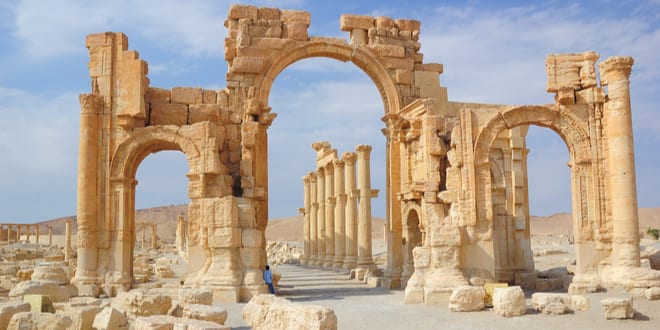The Russian and Syrian governments have just announced that they are moving on to the next stage in reconstructing the ancient temple of the pagan god Ba’al in Palmyra. If successful, the project could be seen as embodying the third incarnation of the Roman Victory Arch of Palmyra which an ancient Jewish source states must fall and be rebuilt three times before the arrival of the Messiah.
On Wednesday, the Syrian Trust for Development, Directorate-General for Antiquities and Museums and the Institute for the History of Material Culture, Russian Academy of Sciences signed an agreement to start the second phase of the project for restoring the Arch of Triumph that stood outside of an ancient pagan Temple in Palmyra, Syria.
“The tripartite joint agreement signed Wednesday founds for the next stage represented in rebuilding the Arch of Triumph after the end of the first stage funded by the Syrian Trust for Development”, the Director General of Antiquities and Museums, Dr. Nazir Awad, said in a statement to a SANA reporter.
For her part, Director of the Institute for the History of Material Culture at the Russian Academy of Sciences Natalia Solovyova indicated that the project to restore the Arc is one of the most important symbolic projects in the world, so all concerned parties were involved in it to get the best result.
Restoration work began in April 2021 after a memorandum of understanding was reached between the Syrian Ministry of Culture and the Association Stone Industry of Russia. In 2019, the State Hermitage Museum in Saint Petersburg announced plans to restore the site in conjunction with the Institute of the History of Material Culture of the Russian Academy of Sciences and Syria’s Directorate General of Antiquities and Museums (DGAM). The project will also be under the auspices of the United Nations Educational, Scientific and Cultural Organization (UNESCO).
The ruins of the ancient city of Palmyra located about 135 miles north of Damascus were a huge tourist attraction, drawing 105,000 visitors a year until the devastating civil war broke out in Syria in 2011. The temple and much of the site were destroyed by the Islamic State (ISIS) in 2015. The Monumental Arch, a centerpiece of the site that was mostly destroyed, was built during the reign of Roman Emperor Septimius Severus in about 200 CE. It is estimated that only 30-40% of the stones in the arch remain.
The site, once a vital point on the Silk Road caravan route, has artifacts dating back to the Neolithic period. The Temple of Palmyra was dedicated in 32 CE to the worship of Ba’al. The earliest known inhabitants were the Amorites in the early second millennium BCE. As such, it hosted many monumental projects including the Temple of Bel (or Ba’al). The temple was built on the site of a prior pagan temple dating back to the third millennium BCE. The most recent of the temples were dedicated in 32 CE. Converted into a Christian church during the Byzantine Era, parts of the structure were modified into a mosque by Muslims in 1132. It remained in use as a mosque until the 1920s.
The arch stood at the entrance to the temple used to worship Bel, also known as Ba’al. Mentioned more than 90 times in the Bible, most notably when Elijah defeated the priests of Ba’al, also known as Moloch, in a contest to bring down fire from heaven to burn a sacrifice, Ba’al became the archetypical form of idol worship. Pantheistic, his adherents worshipped Mother Nature while denying the existence of a creator. Followers of Ba’al engaged in bisexual orgies and sacrificed human infants, burning them alive. Anthropologists conjecture that the child sacrifice was to cull the population after the inevitable outcome of wanton sexuality.
In Jewish tradition, the Arch of Palmyra may be alluded to as a harbinger of the Messianic era. An arch that is repeatedly built up and destroyed is described in the Talmud (Tractate Sanhedrin 78a).
The disciples of Rabbi Yossi the son of Kisma questioned him, asking when the son of David (the Messiah) will appear. And he answered: I am afraid you will request me a sign as well. And they assured him that they would not. He then said to them: When this gate will fall, be rebuilt and fall again, be rebuilt again and fall again. And before it will be rebuilt for the third time the Messiah will appear.
Rabbi Shlomo Yitzchaki, a preeminent medieval rabbi known by the acronym Rashi, explained this section of the Talmud, stating that the arch described by Rabbi Yossi was “a Roman arch in a Roman city.” The arch in Palmyra was indeed a Roman victory arch built when Palmyra was a Roman city.
By advocating for reconstructing a temple of Ba’al, one could say that the UN is violating a Biblical mandate since the third Noahide law is a prohibition against idolatry.
Palmyra was listed as a world heritage site by UNESCO in 1980, which described the temple as “one of the best-preserved and most important religious edifices of the first century in the Middle East.” Palmyra is approximately 370 miles away from two other UNESCO Heritage sites listed as having Muslim significance: Jerusalem and Hebron.




